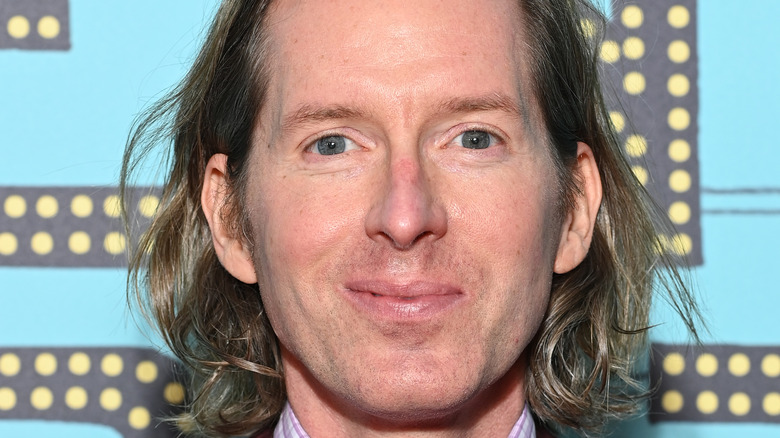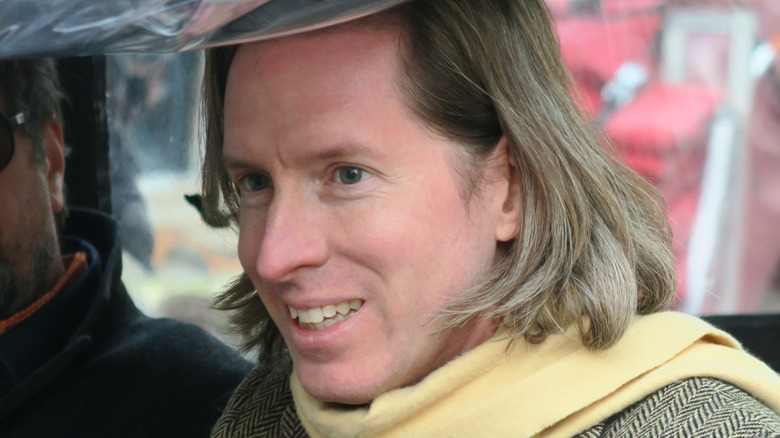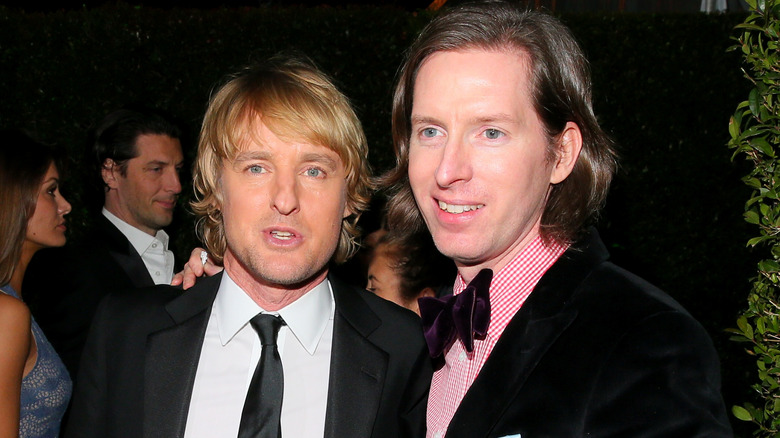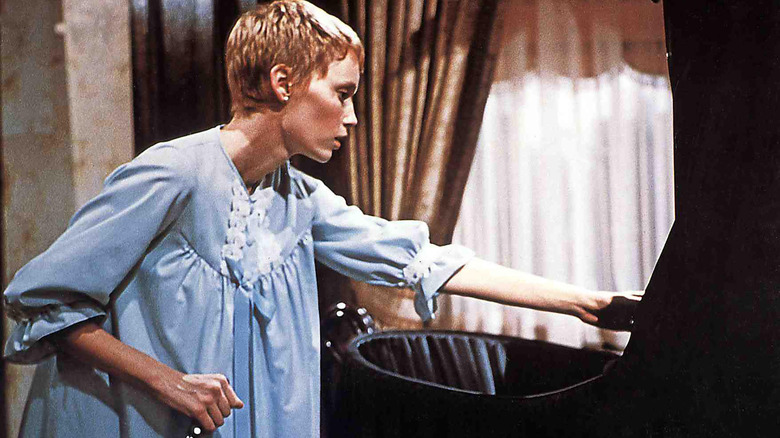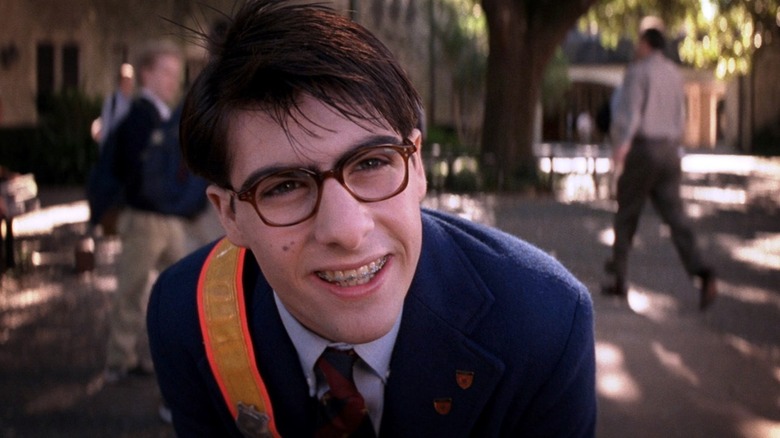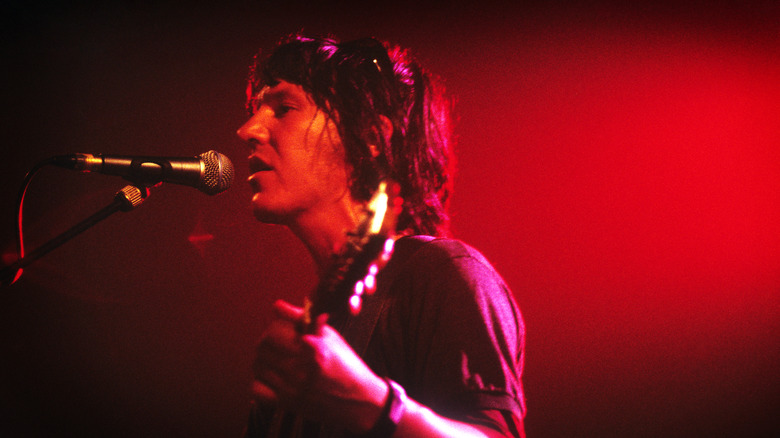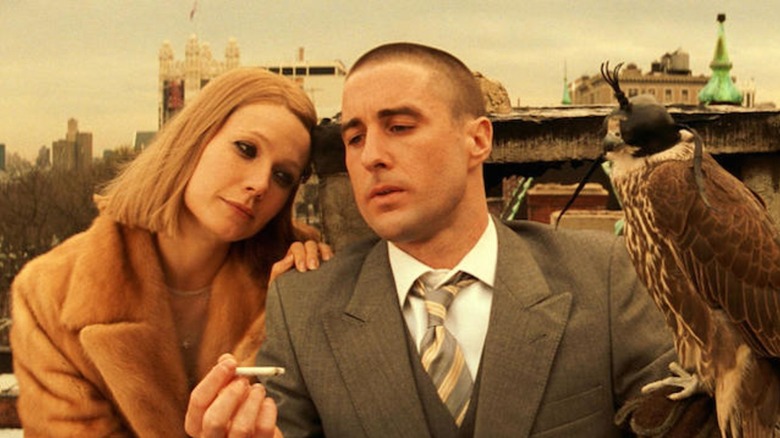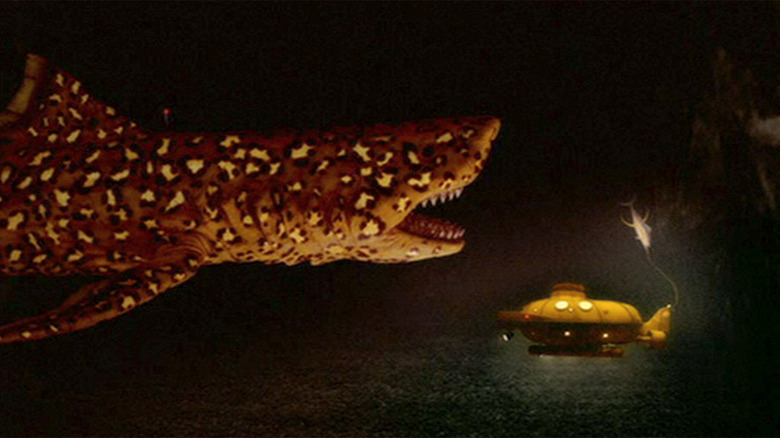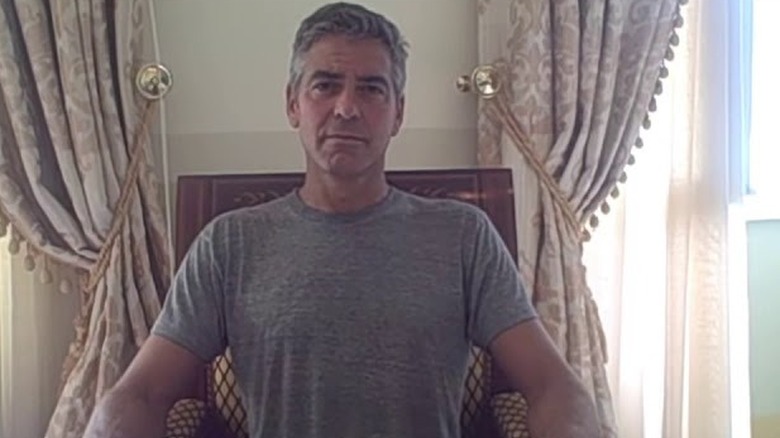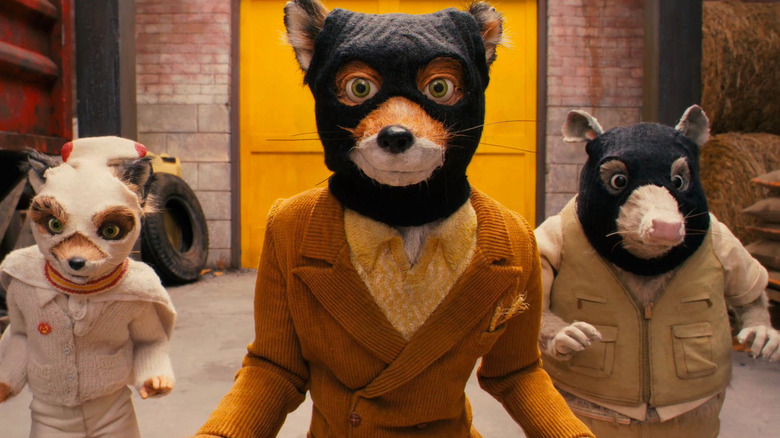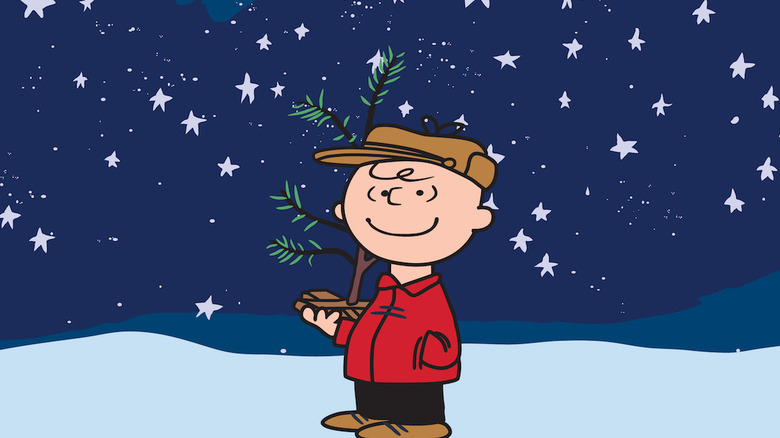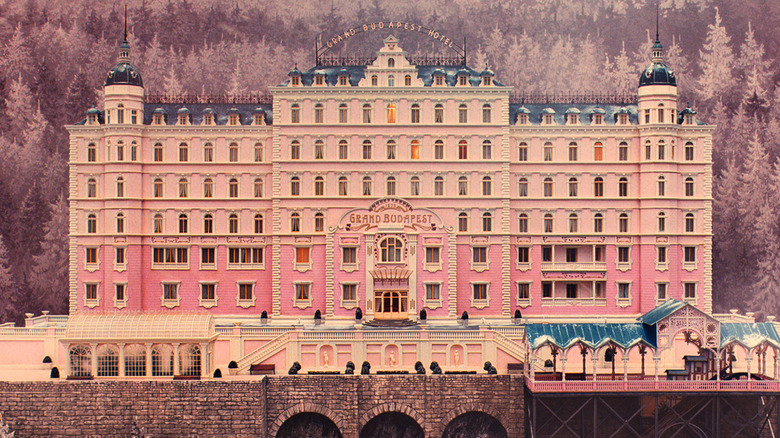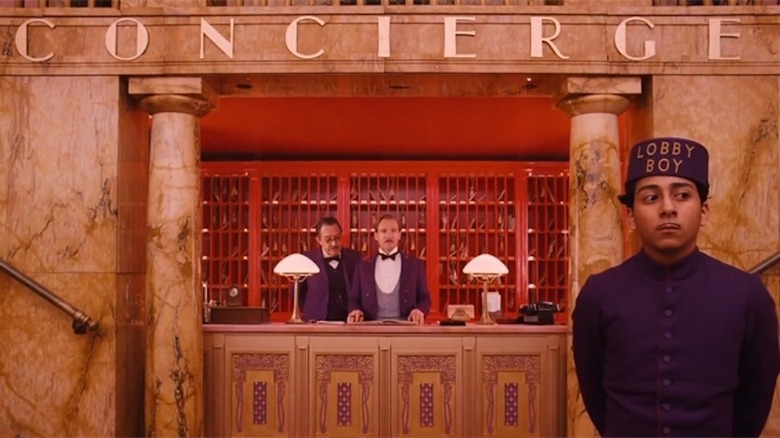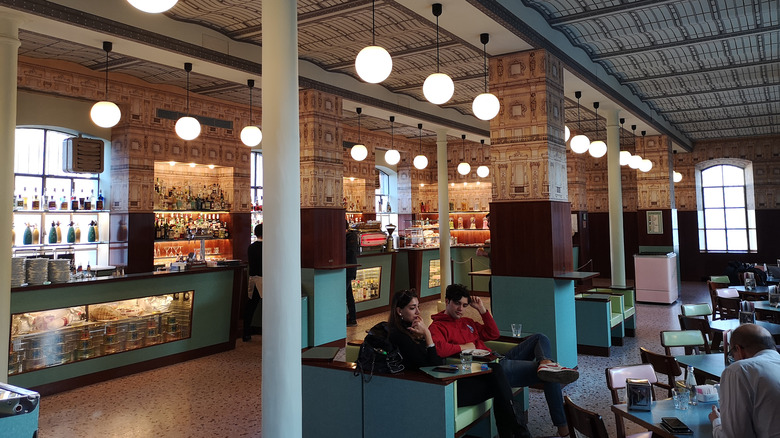The Untold Truth Of Wes Anderson
The wonderful worlds of Wes Anderson are some of the most imaginative in modern American cinema.
As a stylist, Anderson is unmatched. His best movies, including "Rushmore" and "The Grand Budapest Hotel," are known for their witty characters, audacious colors, and attention to detail in every frame. His lens captures a child-like wonder, juxtaposed with dark topics, perhaps best illustrated in "The Royal Tenenbaums." Through the creation of a distinct visual identity and a steady stable of actors including Owen Wilson, Bill Murray, and Anjelica Huston, the filmmaker's trademarks have made him a rarity in today's cinema: an artist whose every shot is immediately recognizable for the person behind the camera.
Details about Wes Anderson's background help explain the unique ways he has assembled his filmography. While many of his films may feel like they come out fully-formed, unconventional casting and directing decisions have often happened on the fly, bringing a certain quirky kismet to his ways that feels like something out of ... well... a Wes Anderson movie. From "Bottle Rocket" to "The French Dispatch," this is the untold truth of his life and career.
His parents divorced when he was 8 years old
Wes (born Wesley Wales) Anderson was the child of a divorce, which would one day have a tremendous influence on his films. Born to Texas B. Anderson and Mel Anderson in 1969 in Houston, the filmmaker's parents' divorced when he was eight years old. This disruption of a "traditional" family dynamic would later inspire many of the adult characters in his adolescent-driven narratives.
Look at Anderson's early work, and you'll see it littered with broken families and failed relationships. "Tenenbaums" is centered around a divorce and the characters of Royal (Gene Hackman) and Ethel (Anjelica Huston) Tenenbaum showing the long-term negative impact it has on the family. Many male characters in Anderson's movies, like Herman Blume (Bill Murray) in "Rushmore," have relationship-ruining affairs; his female characters are often stuck with the repercussions of such philandering (see Anjelica Huston's roles in "Tenenbaums" and "The Darjeeling Limited").
Often, Anderson gives children characters adult feelings and personalities (like in "Moonrise" and "Rushmore"), perhaps alluding to the fact that he was forced to grow up early. Even as recently as "The French Dispatch," his movies have themes that emphasize the unnoticed similarities and radical differences between adults and adolescents.
He and Owen Wilson met at the University of Texas
One of Anderson's earliest, most important and enduring friendships was forged when he met Owen Wilson in college. Both of them were attending the University of Texas at Austin.
"Owen and I had a mutual friend who had gone to my school in Houston and had subsequently gone to military school with Owen in New Mexico, and we knew about each other through him," Anderson recalled while speaking to the Hollywood reporter in 2012. "We met without him introducing us, because we were in a class together — a playwriting class — and we never spoke during the class, but, at the end of it, we realized that we were the people who our friend knew. Somehow, it occurred to us; Owen just walked up to me in the hall one day and started talking to me as if we knew each other."
Hitting it off, they soon became roommates — and shortly thereafter, the duo began brainstorming ideas that would eventually yield their debut film.
"We were both writing short stories, and we started showing them to each other and getting help from each other with them," Anderson explained. "Owen was sharing an apartment with the mutual friend, who had moved to Austin along the way, after we'd been in this class together. They'd gotten the apartment that we shared together, and we started working on 'Bottle Rocket' as a feature script. We wanted to write a movie script, and that was the script we came up with. We started trying to film it as a feature with some money from our fathers — we each borrowed $2,000 — and we ran out of money, and it became a short."
One of Anderson's favorite movies is Rosemary's Baby
"Whimsy" is the word that comes to mind for some when thinking of Anderson's filmography. But while clear through lines can be made from the director's work back to influences like the French New Wave and Italian surrealist Federico Fellini, his choice of favorite movie might surprise you.
Roman Polanski's "Rosemary's Baby" isn't something that would seem to have any clear parallels in Anderson's work. Nevertheless, the 1968 horror classic has had a sizable impact on the filmmaker.
"One movie that I often find myself going back to is 'Rosemary's Baby,'" he told Rotten Tomatoes in 2012. "This has always been a big influence on me, or a source of ideas; and it's always been one of my favorites. Mia Farrow gives a great, big performance in it, and I've read the script and it's a terrific script."
Rushmore was inspired by Anderson's experience at school
Many Anderson aficionados still may not realize how much of his early work had an autobiographical element. "Rushmore" is perhaps the most explicit in this sense; the film was not only shot at St. John's School in Houston, where he went to high school, but also was largely based on his experiences there.
The A.V. Club went back to Houston to explore the school and interview some of Anderson's old classmates, who had plenty of similarities to point out. In a 1999 interview with SFGate, Anderson compared himself to the film's plucky protagonist, Max Fischer.
"Max is like me, except he's not shy," he explained, saying that his fourth grade teacher would let him put on plays inspired by "Starsky & Hutch" to make him feel better about what was going on at home. "My parents were getting divorced. It was kind of horrible. I couldn't accept it for the longest time... I was having a problem with self-discipline. So this teacher who knew I liked to write plays made this deal that every two weeks that went by that I didn't have this self-discipline problem I got to put on another play."
Anderson eventually graduated from the school — unlike poor Max, who gets kicked out.
He had Elliot Smith record a Beatles cover for The Royal Tenenbaums
There have been so many memorable marriages of music and moment in Wes Anderson movies — "Ooh La La" in 'Rushmore," "These Days" in "Tenenbaums," "Let Her Dance" in "Fantastic Mr. Fox," all that Seu Jorge/David Bowie music in "The Life Aquatic with Steve Zissou" — but another came in "Tenenbaums" via the Mutato Muzika Orchestra, covering "Hey Jude."
This take on the iconic tune plays during the film's prologue; Anderson had wanted to use the actual Beatles song, but couldn't get access to the rights during that early 2000s period where the surviving Beatles were still largely hesitant about such things. Initially, Anderson reached out to Elliot Smith for a cover, and the indie crooner agreed. But believe it or not, what came out of that recording session was judged to be subpar, and Anderson decided to not use it.
"We had gone through a long process of trying to get permission for these Beatles songs and in those days they weren't doing it," Anderson said in 2014. "Paul McCartney had seen ['Tenenbaums'] and he said yes, but George Harrison was sick and dying. You had to get everybody to sign off and George was just not possible, no one was going to say, 'Oh before you die could you please watch this movie and tell us whether we can use the music for it?'"
Hence, the Smith solution. Although ultimately, it didn't work either.
"He did a version but he wasn't in a great mental or physical space at the time and it just was not a successful recording session," Anderson explained. "It was kind of a mess ... he wasn't happy with it and it didn't really work."
Mordecai the Hawk was kidnapped and held for ransom on the Tenenbaums set
In "The Royal Tenenbaums," Gwyneth Paltrow plays Margot, the moody, promiscuous daughter of the family. She and Richie (Luke Wilson) take care of a hawk on the rooftop who they've affectionately named Mordecai. However, in real life, the bizarre saga of what happened to that hawk is as interesting as any of the animal's scenes in the movie.
The first hawk the crew was using to play Mordecai was kidnapped and held for ransom (via Far Out). Instead of paying the ransom, the producers decided the best move would be to simply replace the hawk. The kidnappers were never heard from again, to this day nobody knows what happened to the original Mordecai.
That strange on set switcheroo is cleverly referenced in the movie's dialogue. Late in the movie, Richie looks at Mordecai and says "see, now he has more white feathers on his neck."
The Life Aquatic featured the largest stop-motion puppet to date
The 2004 Bill Murray-led "Life Aquatic" quickly became one of Anderson's most polarizing films, failing to earn the usual critical adulation heaped upon the filmmaker. But the film still has plenty worth recommending, and even set a record while it was being filmed.
"Aquatic" centers around the Jacques Cousteau-like Zissou and his "Moby Dick"-inspired hunt of a giant jaguar shark. The prop used in the movie's climactic showdown was every bit as big as you think.
"The puppet of the shark — it's a stop-motion puppet — was very big," Anderson said in 2014, giving credit to his collaborator, the man who directed "The Nightmare Before Christmas." "Henry Selick, who was doing the animation, said it was and is the largest stop-motion puppet anybody ever made."
Of course, the shark also lends itself to one of the film's key questions: Just what has Zissou been searching for during all these years at sea?
"I remember Scott Rudin, our producer, saying to me when I was writing it, 'What is the metaphor with the shark?'" said Anderson in the same interview. "I said, 'I don't know but I like that we're thinking of it as a metaphor. Let's just let it be a metaphor.'"
He had actors record their scenes for Fantastic Mr. Fox
Not long after the stop-motion puppeteering of "Aquatic," Anderson decided to take a left turn into animation. His first animated film was a warmly-received stop-motion adaptation of Roald Dahl's "Fantastic Mr. Fox."
One unconventional method Anderson used to achieve the film's unique tone was making actors like George Clooney, Meryl Streep, Willem Dafoe and Bill Murray record their lines ... outside.
Aside from providing a natural background din of crickets and birds, the move took the traditionally lonely, boxed-in experience of dubbing a voice in a recording booth and made it more of an adventure. In the behind-the-scenes short "The Making of Fantastic Mr. Fox — Recording the Voices," viewers can see Anderson, Clooney and others strolling in the grass, running their lines.
Clooney, in particular, seems to have really enjoyed the experience. He can be seen running, tumbling and popping up with Mr. Fox's signature tongue click, clearly immersing himself in the role.
Fantastic Mr Fox was the first book Anderson ever owned
If you've seen "Fox," you know it's a labor of love. You might not have realized, however, just how much the writer-director revered the source material for this, his only adaptation ("The Grand Budapest Hotel," to be precise, is loosely adapted from the Stefan Zweig novel "Beware of Pity").
"It was not only the first Roald Dahl book I ever read, it was the first book I ever owned," Anderson said in the film's press notes. "I loved the character of Mr. Fox, this sort of heroic and slightly vain animal."
Given his love for the author, it is no surprise that one of Anderson's upcoming projects could be another Dahl adaptation.
Many of his movies reference Charlie Brown
Alongside "Rosemary's Baby," one of Wes Anderson's most unexpected influences might be Charlie Brown.
The filmmaker is a huge "Peanuts" fan, and callbacks to the iconic characters of the comic strip and cartoons can be found throughout his filmography. In "Rushmore," Max's dad is a barber, the same profession as "Peanuts" creator Charles Schultz. In "Moonrise Kingdom," the dog is named Snoopy. And the list of homages goes on, including, but not limited to, musical references to the "Charlie Brown Christmas Special" found in multiple Wes Anderson movies (via Slate).
The "Peanuts" influence is felt in Anderson's characters and themes as well. Charlie Brown is a child dealing with some pretty dark thoughts and feelings. That same youthful melancholy can be seen in some of Anderson's young protagonists, like Max and Margot.
Come to think of it, "Moonrise Kingdom" might just be the film most inspired by "Peanuts" animator Bill Melendez. In addition to the aforementioned Snoopy reference, the movie is about kids dealing with emotional issues without the help of parents.
He booked a hotel for everyone to live in while filming Budapest
Over the course of his career, Wes Anderson has by and large stuck to working with the same recurring cast of actors. Many of these Wes Anderson regulars appeared in the cast of his 2014's "The Grand Budapest Hotel," which marked a distinct return to form for the filmmaker.
This bittersweet adventure, still the highest-grossing movie of Anderson's career, is filled with stars like Adrien Brody, Jeff Goldblum, Saoirse Ronan, Tilda Swinton, and more. Even more impressive is that they apparently all lived together in one building.
The living situation for "The Grand Budapest Hotel" was a bit different than most Hollywood sets. Since Anderson believes a more communal living situation leads to a better attitude on set (per The Guardian), the director booked a hotel in Görlitz, Germany for the cast and crew to live together for the duration of filming. Anderson feels that this helped his actors bond and keep up morale.
The hotel staff in The Grand Budapest Hotel were actual hospitality workers
A great deal of "The Grand Budapest Hotel" takes place inside the titular resort, owned and operated by Gustave H (Ralph Fiennes). Throughout the film, characters interact with a variety of extras who play the various staff working around the Grand Budapest. In real life, some of these people weren't "extras" at all — in fact, they were actual hospitality workers from real-life hotels similar to the Grand Budapest that Wes Anderson imagined for his now-classic movie.
A producer on the movie, Jeremy Dawson, told Variety in 2014 that all the workers behind the front desk in the film were from hotels the crew had stayed at while scouting locations. According to Dawson, two of the extras worked at German hotels in Gorlitz, and another was the concierge of the Atlantic Hotel in Hamburg.
He designed a cafe in Italy
Perhaps the most out–of-left-field project Anderson has ever undertaken was in 2015, when he designed a cafe bar in Milan.
Named Bar Luce, upon opening the caffeine outpost was every bit as meticulously detailed and colored in pastels as any Anderson film. The aesthetics of the space were inspired by the typical Milanese cafès of the 1950s and 1960s, as well as pieces of Italian Neorealist art. Located within the Fondazione Prada indoor art center in Milan, the cafe has an arched ceiling and patterned decoration on the walls that come together to complete the vibe that the filmmaker has embraced for decades.
"The approach I used to design this bar is exactly the opposite I usually use for the set designs of my movies," Anderson explained of his design. "When I was really young I wanted to be an architect and this chance I've been given to pretend to be a real one is a childhood fantasy come true."
